
|
SEMA (Specialty Equipment Market Association) was founded in 1963 by a small group of manufacturers producing automotive performance parts.
This association was formed to set standards, promote the industry and develop programs that would support aftermarket products.
The organization has expanded to include additional interests of its members – government legislation, foreign trade, education, market research, etc.
And, the membership has grown to comprise all aspects of the business which now includes retailers, warehouse distributors and publishing companies.
To bring the stakeholders from the performance aftermarket together the first trade show was organized in 1967.
The event was held in Los Angeles – it attracted just under 100-manufacturers and approximately 3,000 attendees.
In 1977, the SEMA Show moved to Las Vegas which was better equipped to handle the growing requirements of manufacturers and attendees.
Today, the show, at the Las Vegas Convention Center (over a million square feet of floor space), boasts over 2,400 exhibitors and more
than 170,000 people with ties to the automotive performance aftermarket. Visitors from 140 countries can see the hottest automotive products and attend
demonstrations, educational seminars and special events.
|

|
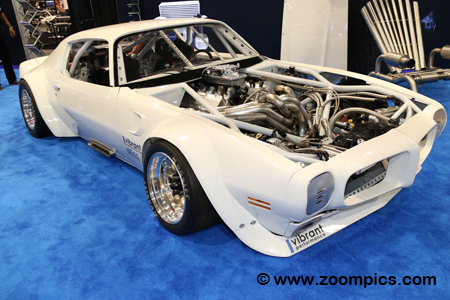
|
Located in the Vibrant Performance booth at SEMA was this 1970 Pontiac Trans Am built by Riley Stair.
The normally aspirated 1,000-horsepower motor is a 400-cu.in. LSX from Dart Machinery.
With the hood removed the eight into one header is exposed.
This style of exhaust was used by short track and Trans Am series competitors in the early ‘80s.
The tube-frame chassis is equipped with a modern suspension system and Panasport 16-inch wheels.
|

|
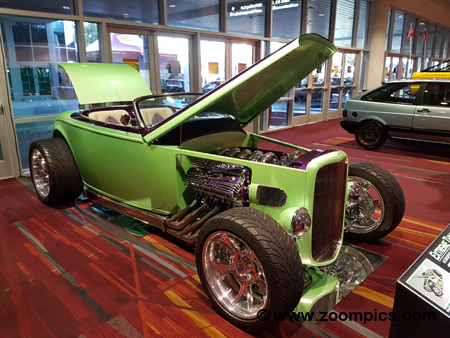
|
Believe it or not, this car was built to showcase the motor.
Called, Extreme Thunder this hot rod is fitted with a 904-cu.in. engine produced by Schubeck Racing Engines.
It was created as an alternative to the Chrysler Hemi used in many blown nitro drag racing applications.
The engine is a double-overhead camshaft design with four-valves per cylinder.
The bore on the V8 block is 4.9-inches and the stroke is 6-inches.
|

|
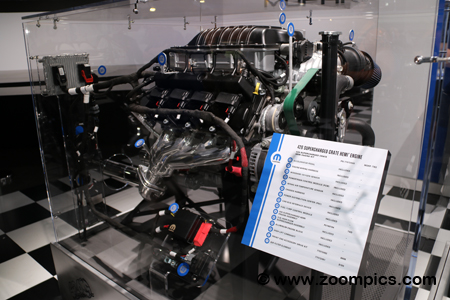
|
Grabbing a lot of attention was Mopar’s new 426 Supercharged Crate Hemi engine.
The 1,000-horsepower motor has already been nicknamed the ‘Hellephant’.
The aluminum block has a 4.0-inch cylinder bore and 4.125-inch stroke.
Although the price hasn’t been released the kit includes almost everything you need to ‘plug and play’ –
sensors, modules and wiring. Prospective buyers will have to purchase an air filter.
|

|
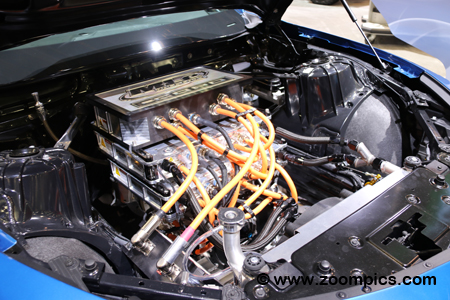
|
In the not so distant future when you ask to look under the hood, this may be what you will see.
General Motors brought their 2019 Chevrolet eCOPO Camaro Concept.
The electric dual motor stack produces 750-horsepower and 600-lb.-ft. of torque.
The Camaro is equipped with four 800-volts batteries – two in the rear seating compartment and two in the trunk.
Apparently, the car runs in the nines.
|

|
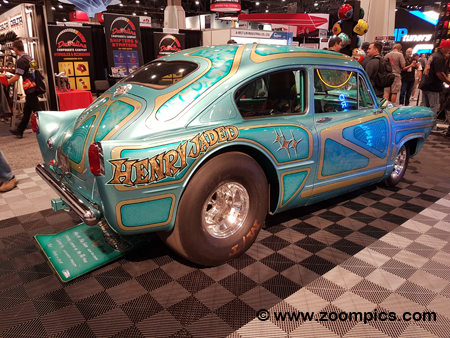
|
The House of Kolor always brings a couple of unique vehicles to showcase their product line.
In addition to a 1948 Ford Anglia, they had this Henry J in their both.
The original Henry J was built by the Kaiser-Frazer Corporation and named after its chairman, Henry J. Kaiser.
The owner of this car, Daniel K. Nelson has named it the Henry Jaded.
Henry Jaded was built by Dave Shuten of Galpin Auto Sports.
|

|
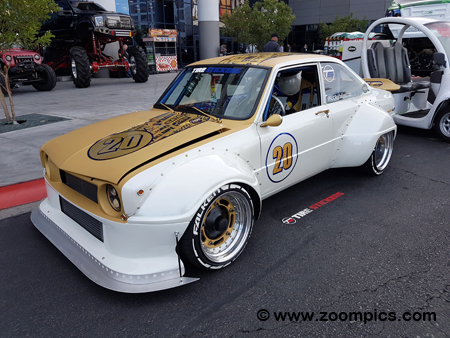
|
Parked in front of the LVCC South Hall was this 1972 Mazda R100.
This car has very little in common to the R100 that was introduced to the North American market in 1971.
The original 100-horsepower 10A engine has been replaced with a three-rotor 20B motor producing more than 1,000-horsepower.
Other than the shell every part on the Mazda has been hand fabricated or purchased from the aftermarket.
|

|
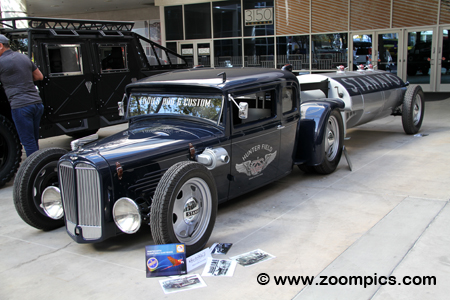
|
Making it to SEMA’s Battle of the Builders and winning the truck category was this 1932 Willy Aircraft Refueling Truck.
Eddies Rod & Custom from Cedar Rapids, Iowa is responsible for this creation.
The Willys was started life as a four-door sedan but the custom bodywork resulted in it becoming a two-door Semi.
The truck is powered by a Datsun 720 Turbo Diesel – the original turbo has been replaced with a Garret unit.
|

|
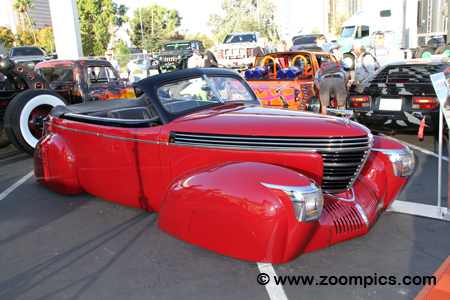
|
Hot Wheels had a large presence at this year’s SEMA show.
This streamlined art-deco car is called ‘The Graham’.
The car was originally built by a small manufacturer in Detroit called The Graham Company.
The drivetrain is mostly built with Ford components – 302-cu.in. engine, nine-inch differential and automatic overdrive transmission.
Updates to ‘The Graham’ are credited to the builder and designer, Steve Howard.
|

|
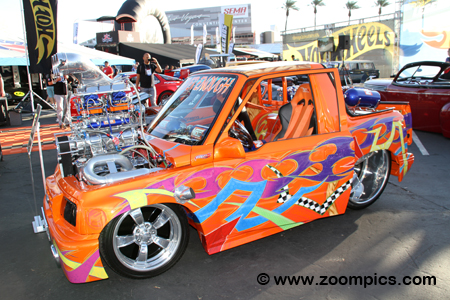
|
Another vehicle found in the Hot Wheels area was this 1994 Geo Tracker.
Delton Hubbard along with family and friends built this one of a kind life-size Hot Wheels creation.
Aside from the paint job your eyes are immediately drawn to the engine – a 355-cu.in. small block Chevrolet with a 671
Weiand blower and two 750 Holley carburetors. The horsepower is transmitted through a Creech Performance transmission.
|

|
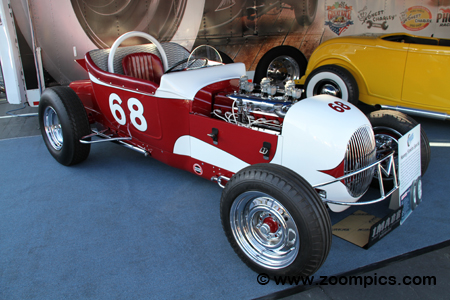
|
The Mooney/Simkins Special was built in the late 1940’s by Fay Mooney, Spud Simkins and Johnnie Johnson
to compete on the dirt tracks of southern California. The body and chassis of the Special is a modified 1925 Ford Model T.
Powering the car is a 270-cu.in. GMC straight six-cylinder engine.
A recent restoration of this car was completed by Image Street Rod and Customs of Santa Maria, California.
|

|
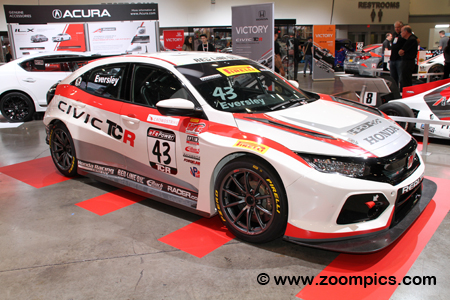
|
On display in the Honda area was the Pirelli World Challenge championship winning Honda Civic Type-R TCR.
The Honda was raced by Ryan Eversley who won five of the twelve races on the way to the TCR title.
The 2.0-liter turbocharged double-overhead camshaft engine in the car produces 340-horsepower at 6200 rpm.
Some other features of this Civic include a six-speed sequential transmission and front brakes with six-piston calipers.
|

|
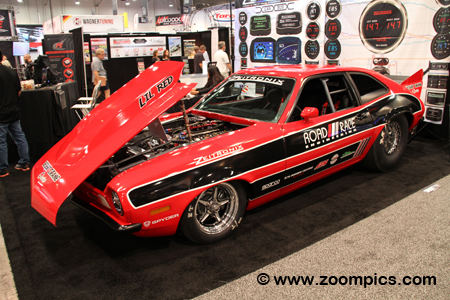
|
Lil Red is a 1971 Ford Pinto owned by John Rogers and driven by Ricky Rogers.
The car has a full chromoly chassis with the wheelbase stretched to 100-inches.
The drive train includes a 557-cu.in. Ford Racing Siamese block connected to an ATI Superglide transmission
which has an ATI torque converter and trans brake. The bodywork was performed by Jessup Autobody.
|

|

|
In the Royal Purple booth was this 1961 Chevrolet Panel Truck owned and constructed by Tim Strange.
Just about every component on this truck has been replaced.
The Royal Purple Panel Truck is powered by a Lingenfelter 6.0-liter engine which is fitted with a Holley intake,
injectors, fuel rails which are controlled by a Holley Dominator computer.
The transmission is from B&M with a Currie Fab nine-inch Ford differential.
|

|
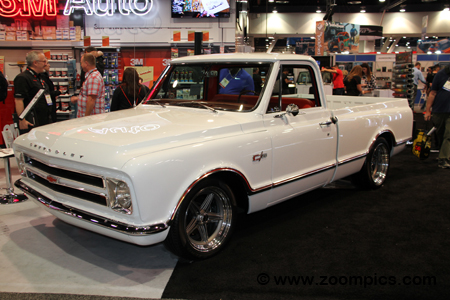
|
There were a number of Chip Foose creations at this year’s SEMA show including this converted 1967 Chevrolet C-10.
Foose’s concept was to install the 302-cu.in. engine from a 1967 Chevrolet Camaro Z/28 into the pickup.
He also incorporated some subtle design cues from the Camaro.
The chassis, engine and transmission have been upgraded with modern parts from the aftermarket.
The result is called a Chevrolet C/28.
|

|

|
This race car appeared in the Gentex booth – suppliers of digital vision systems (mirrors and rear-facing cameras).
The Toyota competed in the FIA World Endurance Championship.
This model, the Toyota TS050 Hybrid was prepared by Toyota Gazoo Racing and competes in the LMP 1 category.
The No. 8 Toyota was driven to victory in this year’s 24-Hours of Le Mans by Sebastien Buemi, Kazuki Nakajima and Fernando Alonso.
|

|
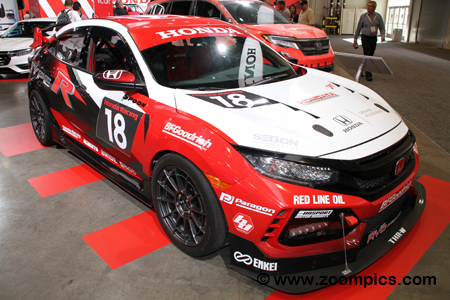
|
Another product Honda showcased was this Civic Type R prepared by Team Honda Research West.
This car competed in the 2017 25-Hours of Thunderhill in showroom stock condition.
In 2018, the Honda has received many upgrades for this year’s event at Thunderhill.
Powertrain upgrades include a Hondata ECU, Injen intake system, Spoon aluminum radiator,
an HPD World Challenge Spec limited slip and oil pan baffle.
|

|
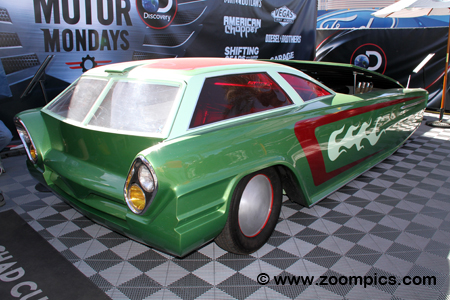
|
The Green Goblin was designed, built and painted by Canadian, Chad Hiltz of Bad Chad Customs.
A 1962 four-door Chrysler Windsor has been fitted to a hand-fabricated chassis.
The roof from the Chrysler has been replaced by a 1974 Oldsmobile Cutlass.
The front floor, tonneau cover and fender skirts are also hand-fabricated.
Hiltz was able to mount the engine and transmission in the rear by using a unit from a 1974 Cadillac.
|

|
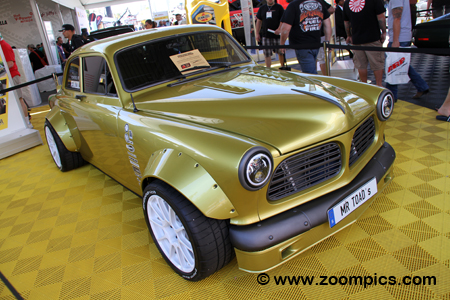
|
The VO6 started life as a humble 1963 Volvo 122S Amazon which was equipped with an 85-horsepower motor.
Jeff Allen owner of the Flat 12 Gallery converted the Volvo into a very aggressive package.
The original engine was replaced with a Lingenfelter Performance ZO6 power plant.
After a cross-country tour, the VO6 will be auctioned off with the proceeds going to the SEMA Memorial Scholarship Fund.
|

|
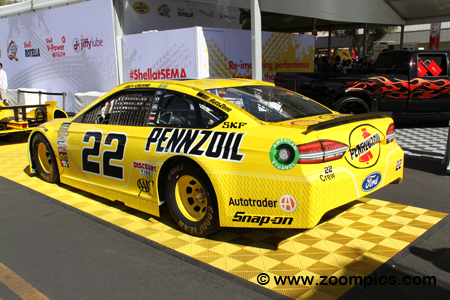
|
The Pennzoil compound had a large number of race cars, exotics and customs on display.
This is the Ford Fusion of 2018 NASCAR championship contender, Joey Logano (winner of the 2015 Daytona 500).
The Ford was prepared by Team Penske and is powered by a 5.9-liter fuel injected FR9 Roush Yates engine.
The motor produces 750-horsepower at 9,000-rpm. Depending on the gearing, the Fusion will travel at a speed of 210-mph.
|

|
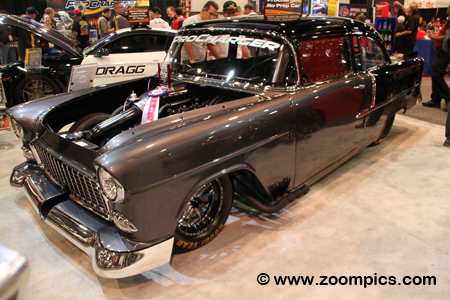
|
In 1955 a Chevrolet 210 Sedan was delivered with a motor that produced 135-horsepower.
Advances in technology have allowed owners, Tom Lincoln and Jerry Jahnsen to develop a ’55 Chevy that has over 3,200-horsepower.
The car was built by Wade Ramsey’s Sarmento Race Cars.
The engine is a Pro-Line/Alan Johnson 481X with a three-speed 400 transmission from M&M Transmission.
|

|
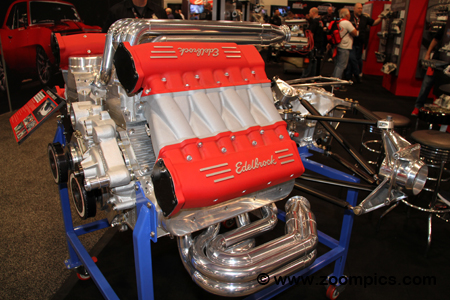
|
This is the Hal Design W16 LS Engine Kit.
An Australian company, Hal Design has mated two Chevrolet LS motors at 45-degrees and joined them using an
alloy plate and bridge running between the two engine blocks.
A specially designed transfer case converts the input from the two crankshafts into a single output.
The result is an 854-cu.in. engine using stock crankshafts, pistons, rods and camshafts to produce 1,400-horsepower.
|

|
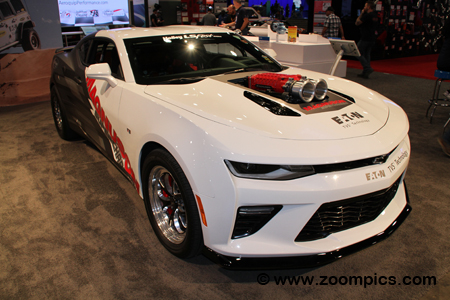
|
Located in the Eaton booth was the Magnuson Camaro a six-generation 2016 Chevrolet Camaro SS.
The car built by Magnuson Products features a laundry list of modifications and upgrades.
The factory 6.2-liter LT1 has a Stage 3 2650 Magnuson supercharger and uses Eaton TVS technology.
The engines internal components include pistons, connecting rods and a crankshaft from Manley.
The transmission and rear have also received upgrades.
|

|
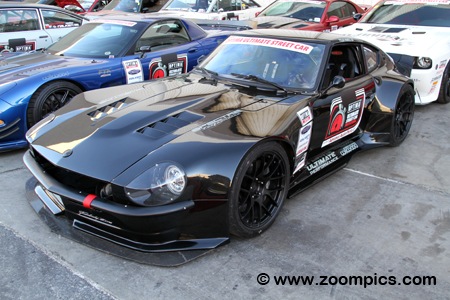
|
Vehicles competing in the Optima Batteries Ultimate Street Car Invitational were scattered throughout the SEMA show.
Most of the participants, over fifty, were located in the Optima Street Car Alley.
Teams qualify at events throughout the year for an opportunity to compete in the final judging at Las Vegas Motor Speedway.
The car pictured is Andrew Tyler Powell’s 1972 wide-body Datsun 240Z which is fitted with an LS7.
|

|
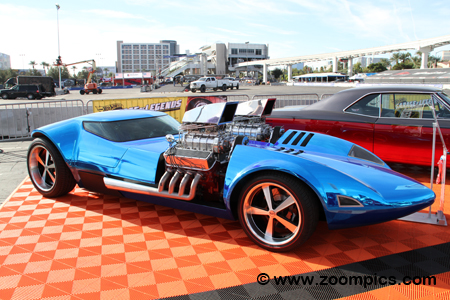
|
And, yet another Hot Wheels vehicle. The ‘Twin Mill’ was introduced in 1968 and is the brainchild of Ira Gilford.
In a first, Hot Wheels commissioned Action Vehicle Engineering to create a full-size version which was unveiled at the 2001 SEMA show.
The custom fiberglass-bodied car is fitted with two Chevrolet 502-cu.in. engines and B&M Blowers –
apparently this combination produces 1,400-horsepower.
|

|
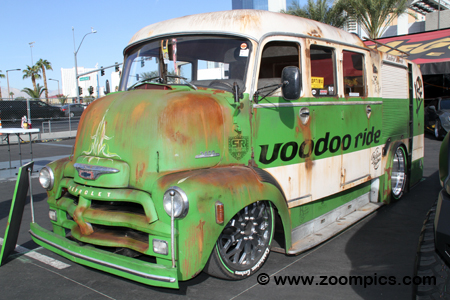
|
This truck was built by a Belgium company called Cobblestone Customs.
This one-off 1955 Chevrolet originally served as a Firetruck.
One of the modern features used on the truck is the 6.6-liter turbocharged V8 Duramax LBZ engine which
produces 360-horsepower and 650-lb.-ft. of torque.
The driveline also includes an Allison transmission and a fourteen-bolt rear end.
|

|
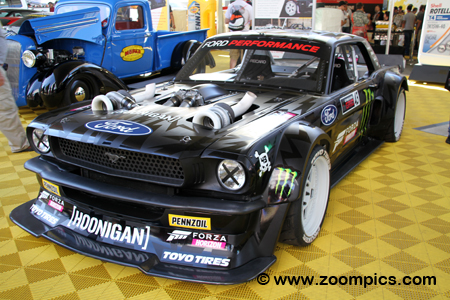
|
This is the 1965 Ford Mustang Hoonicorn RTR V2 based on the original Hoonicorn.
Appearing in the Pennzoil area at the SEMA show it was presented by Hoonigan and the driver, Ken Block.
For version two of the Hoonicorn, twin turbochargers were added and the Mustang now uses methanol – these
upgrades have the car producing 1,400-horsepower. A video called, ‘Climbkhana’ shows the Hoonicorn tackling Pikes Peak.
|

|
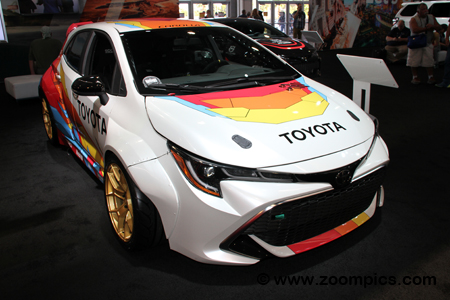
|
Toyota had an extensive collection of vehicles on display including this 2019 Corolla Hatchback.
The Corolla has been modified by Papadakis Racing to compete in Formula Drift events.
Perhaps the most significant job was converting the car from front to rear-wheel drive.
The original engine was changed to a Toyota 2AR-FE equipped with a custom induction system and nitrous oxide.
This replica of the Pro drift car produces 850-horsepower.
|

|
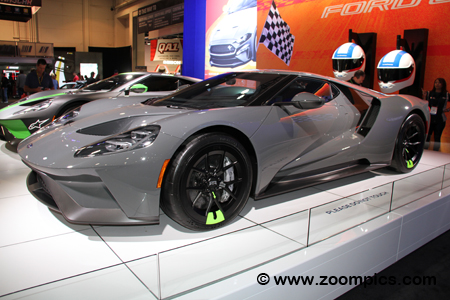
|
On display in the Ford area were two Ford GT.
The cars look similar to previous models but they are the 2019 Ford GT Carbon Series.
The use of carbon-fiber lightens the cars by thirty-nine-pounds.
Contributing to the weight loss is the titanium exhaust, titanium wheel nuts and carbon-fiber wheels.
This special edition of the Ford GT will be available to consumers.
|

|
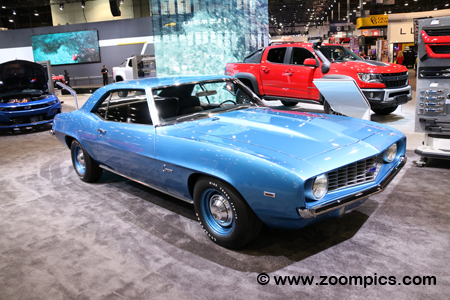
|
General Motors had this 1969 Chevrolet COPO Camaro on display.
The COPO (Central Office Production Orders) concept was introduced in 1969.
COPO Camaros were built for the NHRA’s Stock Eliminator class.
A COPO 9561 order would get you a Camaro equipped with a 425-horsepower 427-cu.in. iron block.
The COPO 9560 came with the 425-horsepower 427-cu.in. aluminum block which is known as the ZL-1.
|

|
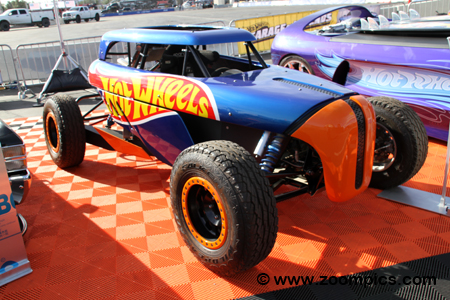
|
This is another Hot Wheels creation – the 2012 Rip Rod.
The Rip Rod was designed by Fraser Campbell and built by Action Vehicle Engineering and ES Motorsports.
It has a custom fabricated tube-frame chassis constructed to perform back-flips.
It is equipped with a four-cylinder 1.0-liter Ford Eco-Boost engine that produces 200-horsepower.
The lightweight package can go from 0 to 60 mph in three seconds.
|

|
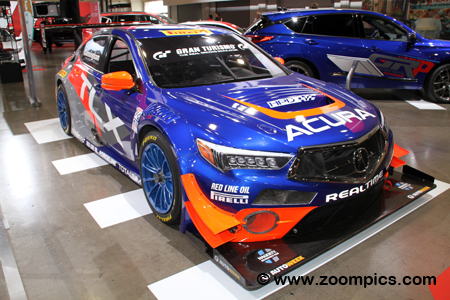
|
In 2014, RealTime Racing returned to the GT category of the Pirelli World Challenge championship with an Acura TLX-GT.
The model which was raced from 2014 to 2016 had some success in the hands of Ryan Eversley and team principal, Peter Cunningham.
This TLX-GT competes in hill climbs and is driven by Cunningham.
At the prestigious, 2018 Pikes Peak International Hill Climb, he won the Open Class and finished third overall.
|

|
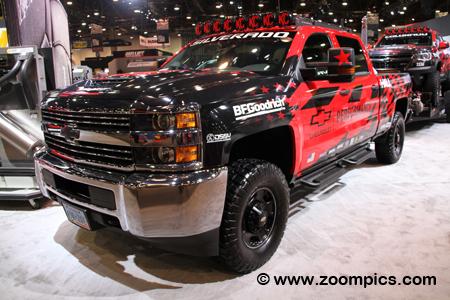
|
Chevrolet not only brought cars to the SEMA show but trucks as well which are gaining in popularity with consumers.
This 2019 Chevrolet Colorado ZR2 Chad Hall Race Truck will not be available at your local GM Dealer.
This Colorado was built to compete in the ‘Best in the Desert Off-Road Racing’ series.
Racers trek a total of 539-miles from Las Vegas to Reno. The Chad Hall entry succeeded in finishing the event.
|

|
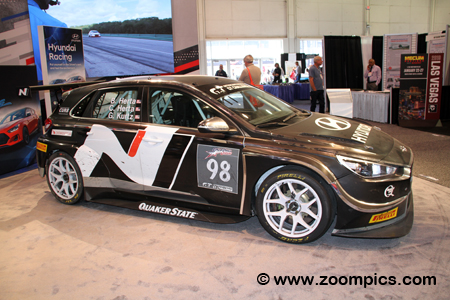
|
This Hyundai was raced on Sunday and appeared on the show floor Monday.
This Hyundai I30 N TCR was entered in the California 8-Hours at WeatherTech Raceway by Herta Motorsports.
Team principal, Bryan Herta, his son Colton and George Kurtz captured the class victory.
The Hyundai racecar is powered by a two-liter turbocharged transverse mounted motor which produces 350-horsepower.
|

|
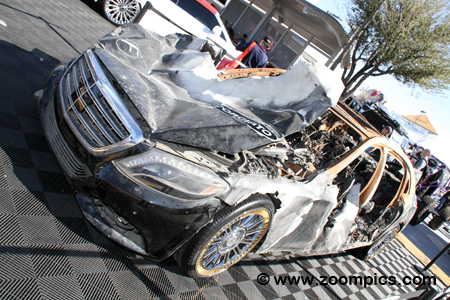
|
In a bold move, Forgiato Wheels used this Mercedes-Maybach S-Class to showcase their wheels.
Apparently, the company’s Director of Marketing said they’d be bringing the ‘most lit’ car to the SEMA show.
True to his word the Forgiato group had this burned out Maybach on display fitted with their 22-inch Orologio rims.
|

|
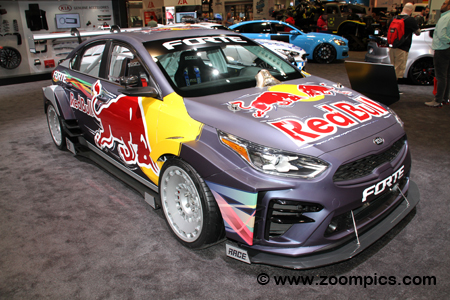
|
Kia’s area featured both production models and modified cars.
This is the Kia Forte Drift Car.
The motor in the 2019 Forte has been replaced with a twin-turbo V6 from a Stinger GT.
The engine was also relocated – moved from its transverse position to a conventional rear-wheel-drive layout.
Other additions to the Kia Forte Drift Car include a six-speed sequential transmission, quick change differential and custom bodywork.
|

|
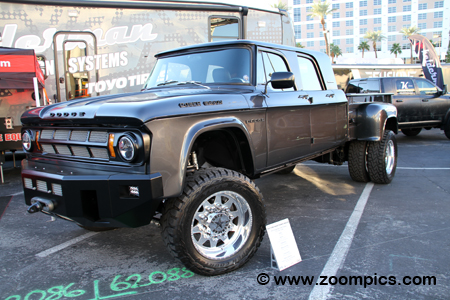
|
The south parking lot in front of the Las Vegas Convention Center was occupied with four-wheel trucks of all shapes and sizes.
Among them was the 1969 Time Warp Power Wagon.
The 1969 Dodge body rests on a 2016 Dodge Ram 3500 chassis powered by a 6.7-liter turbocharged engine.
Built by southern off-road specialists, Time Warp Customs, the truck includes a number of upgrades:
Toyo Tires, American Force Wheels, etc.
|

|
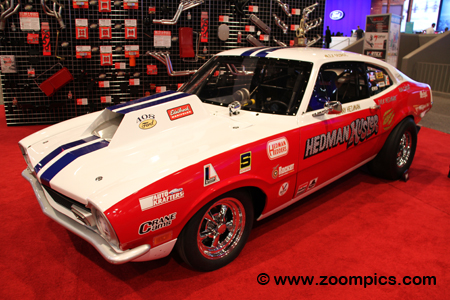
|
This is the third version of the Hedman Husler Maverick.
The original Ford Maverick debuted in 1970 and had a short but successful career as a nine-second
Pro-Stock Drag Car that won many NHRA Division 7 events.
At the end of the season, it was stolen and replaced by version two which was campaigned until 1974.
The latest Hedman Husler Maverick won the Hot Rod class at the 2018 California Hot Rod Reunion.
|

|
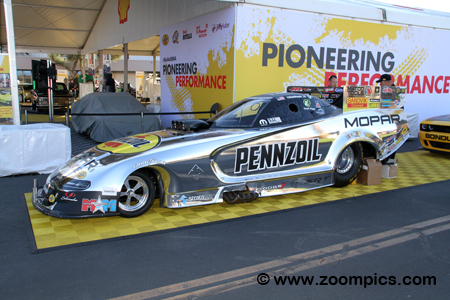
|
One of the many vehicles appearing in the Pennzoil /Shell display was this 2018 Dodge Charger SRT Hellcat Funny
Car from Don Schumacher Racing. This car is equipped with a 500-cu.in. Chrysler Hemi which produces 11,000-horsepower and 8,500-rpm.
The rear slicks are 17.5-inches wide and filled to six-psi which maximizes the grip.
This combination weighs 2,585-pounds and will go from 0 to 100-mph in less than a second.
|

|
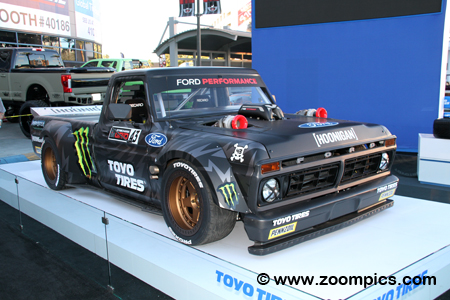
|
A second vehicle that Ken Block had on display was located in an area set aside for Toyo tires.
This is a 1977 Ford F-150 called, Hoonitruck.
The body of the truck is mounted to a tube-frame chassis.
The F-150 is powered by a twin-turbocharged 3.5-liter V6 similar to that used in the Ford GT race cars and is rated at 914-horsepower.
And, like most of Block’s latest creations, the vehicle is all-wheel-drive and fitted with 20-inch wheels.
|

|
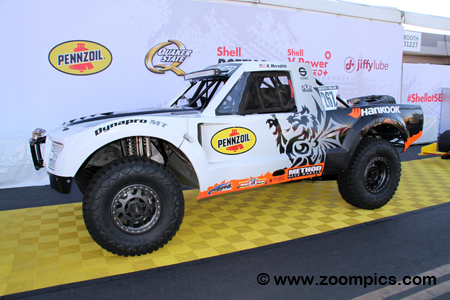
|
This 2006 Chevy LS3 Spec Trophy Truck appeared in the Pennzoil both.
It is campaigned by off-road racing veteran, Rhys Millen.
The ‘Spec Trophy Truck’ class was introduced to reduce the high costs associated with the sport –
current Trophy Trucks can cost as much a $1MM.
This spec category reduces expenses by limiting tires to 37-inches,
equipping trucks with an LS3 Chevrolet engine and 3-speed automatic transmission.
|

|
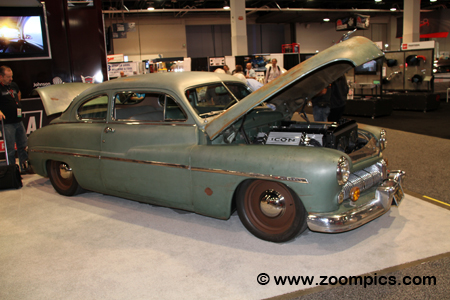
|
As always Optima Batteries had a large presence at the SEMA show which included many unique vehicles.
One of these was this 1949 Mercury Coupe that looks like it was just dragged out of farmer’s field and run through a carwash.
But appearances can be deceiving.
The Mercury is powered by electric motors which produce 400-horsepower and 470-lb.-ft. of torque.
The battery controllers in the engine bay resemble a V8.
|

|
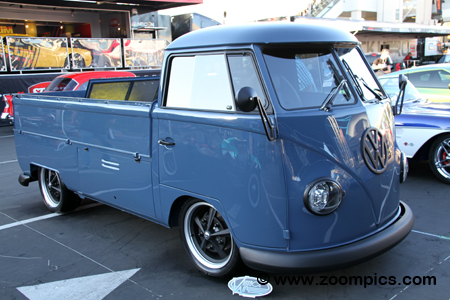
|
This Volkswagen appears to be a nice clean restoration of an old pickup.
But this is SEMA and you know that’s not the case.
The original engine has been replaced with a 3.3-liter H6 from a Subaru.
The motor has been upgraded with custom pistons and forged connecting rods.
And, to boost the horsepower, even more, two turbochargers have been added.
Although the Volkswagen looks stock, it has many modern components.
|

|
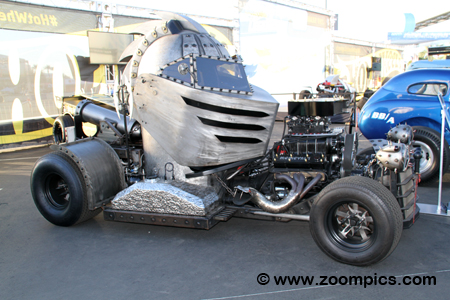
|
Designed by Tony Batterson and constructed by A.J. Bohatta the Medieval1 is another creation for the Hot Wheels line.
Believe it or not, this one-off custom vehicle comes with air conditioning and has been on the road since 2016.
Installed in the front is a 355-cu.in. Chevrolet small-block equipped with a 671 Weiand Supercharger.
If given a 500 shot of Nitrous Oxide the car will make over 1,000-horsepower.
|

|
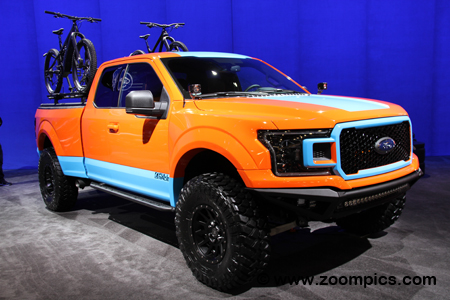
|
On display at Ford was this 2018 Ford F-150 which received the ‘works’ from Full-Race Motorsports.
The F-150 is powered by Ford’s 3.5-liter V6 EcoBoost engine.
Powertrain upgrades include twin-turbochargers with an intercooler kit, cold-air intake, cat-back exhaust and a transmission cooler.
The truck rides on Ion Vehicle Dynamics compression wheels (17X8.5-inches) which are mounted with Maxxis RAZR tires (37X12.5-inches).
|

|
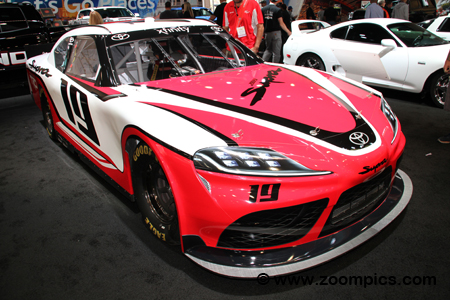
|
Toyota had this 2019 Toyota Supra prepared to NASCAR Xfinity Series rules on display.
This is a significant change for Toyota as they previously campaigned their Camry model.
In developing the Supra, the company worked with their partners, Toyota Racing Development (TRD) and Calty Design Research.
The car is scheduled to make its debut at Daytona in 2019.
|

|
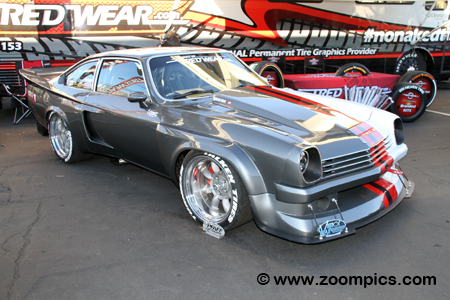
|
This Chevrolet Vega is equipped with bodywork that looks like it’s from IMSA’s 1970s Camel GT Series.
The heavily modified Vega was designed by Pfaff Designs and is owned by Byron Burnham.
A custom chassis is fitted with a 550-horsepower Chevrolet LS3 and a Tremec TKO five-speed transmission.
It also uses a Ford nine-inch differential with a three-link rear-end from Art Morrison. The front brakes are 13-inch Willwoods.
|

|
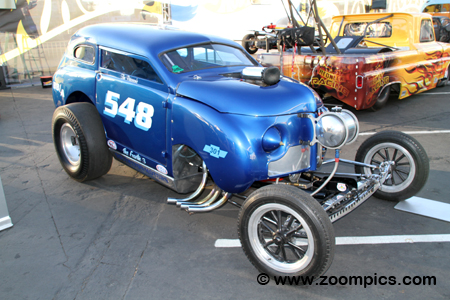
|
The Blue Goose is another Hot Wheels Legend.
The drag car designed and constructed by Elwood Peterson, Bruce Boyce and Gordie McNutt is based on the 1959 NHRA rule book.
The chopped 1947 Crosley body sits on a tube-frame chassis.
The engine is a de-stroked 327-cu.in. Chevrolet equipped with 471 supercharger and two-port Hilborn fuel-injection.
Using only gasoline, the Blue Goose will run a 9.90 ET at 150-mph.
|

|
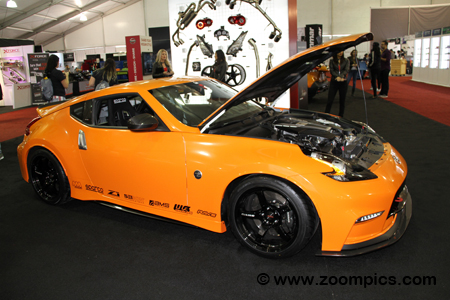
|
Nissan brought this 370Z called, Project Clubsport 23.
What makes this car particularly unique is the engine.
The 3.7-liter VQ engine has been replaced with a 3.0-liter twin-turbocharged V6 used in the Infiniti Q50 400 Red Sport.
The 400-horsepower engine was then fitted to the manual transmission from the 370Z Nismo.
The builders, MA Motorsports, went to great lengths to ensure the under hood appearance remained stock.
|

|
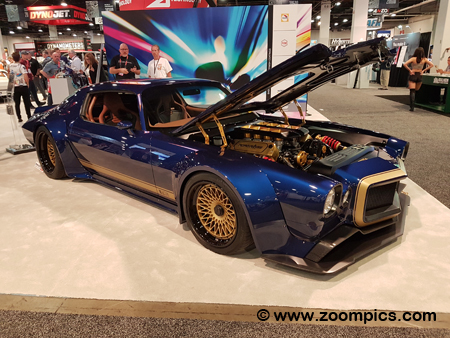
|
Another team making it to SEMA’s Battle of the Builders were Phil and Jeremy Gerber of Gerber’s Roadster Shop in Mundelein, Illinois.
This 1970 Chevrolet Camaro features a carbon fiber wide body and a DBW ITB intake derived from the Daytona Prototype racing class.
The chassis is custom built by Fast Track and features a cantilever suspension fitted with Penske racing coil overs.
The modern interior is by Avant Garde.
|

|
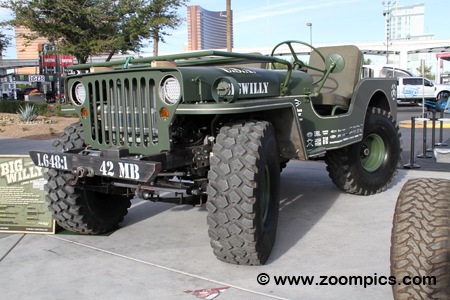
|
Called, ‘Big Willy’ this is a 1.648:1 scale version of a 1942 Willys Jeep.
This was concept was inspired by building a mutant vehicle for Burning Man.
The owner, Ian Liljeblad has created a fully functioning 4X4 which will be tested on the Rubicon Trail in 2019.
The engine in Big Willy is a Cummins R2.8 which is bolted to a Zero Gravity Performance transmission and uses a
transfer case from Keep it Simple Off Road.
|
|
Copyright Notice:
|
All content (photographs and text) appearing on this website are the exclusive property of © www.zoompics.com and are protected under International copyright laws. The subject matter on this website may not be reproduced, copied, stored or manipulated.
|
© Copyright 1999, 2000, 2001, 2002, 2003, 2004, 2005, 2006, 2007, 2008, 2009, 2010, 2011, 2012, 2013, 2014, 2015,2016, 2017 and 2018


